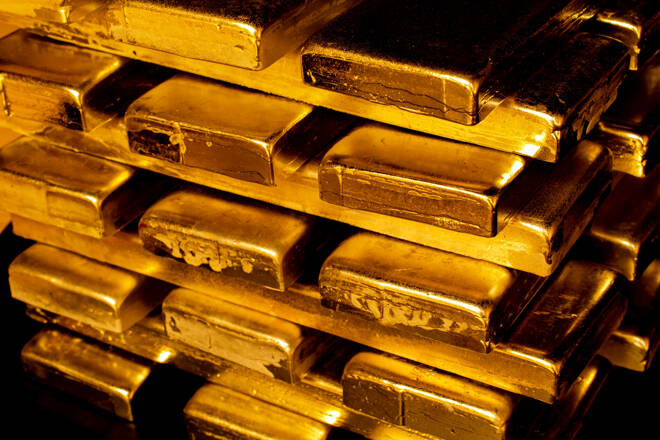Advertisement
Advertisement
Gold (XAUUSD) & Silver Price Forecast: Geopolitical Risk Fuels Uncertainty, Capping Upside
By:
Key Points:
- Gold trades near $3,355 as strong U.S. dollar and Fed hawkishness limit bullish momentum and cap upside below $3,388.
- Silver consolidates near $36.00, struggling to break above $36.31 as technical resistance and cautious sentiment weigh.
- Rising geopolitical uncertainty and tight Fed policy leave gold and silver range-bound ahead of key PMI data.
Market Overview
Gold prices edged lower during Asian hours on Monday, failing to extend gains beyond the $3,360 mark as renewed strength in the U.S. dollar pressured bullion markets. The greenback rallied sharply following U.S. military strikes on Iranian nuclear facilities, dampening demand for the non-yielding metal.
At the time of writing, spot gold trades near $3,355, hovering close to its 200-period EMA, while remaining confined to last week’s narrow range.
“Gold is caught between rising geopolitical premiums and a Federal Reserve that’s unwilling to ease aggressively,” said one commodities strategist at a global bank.
The Federal Reserve’s updated projections now anticipate just two rate cuts in 2024, followed by only 25-basis-point reductions in 2026 and 2027, reflecting persistent concerns over inflation. These expectations have kept the U.S. dollar near recent highs, reducing investor appetite for dollar-denominated assets like gold.
Silver Holds $36 but Lacks Momentum as Dollar Caps Gains
Silver followed gold’s path, trading around $36.00, after briefly dipping to $35.94 during the Asian session. Like gold, silver is facing dual pressure from stronger U.S. dollar flows and cautious market sentiment. The metal’s failure to reclaim levels above $36.30 suggests traders are hesitant to chase rallies without a more straightforward risk narrative.
Both metals are being pulled by two competing forces: rising geopolitical uncertainty and the Fed’s reluctance to pivot more dovishly. The result has been a lack of clear directional conviction in recent sessions.
Investors Await PMI Data and Risk Developments for Clarity
Investor focus is now shifting to Monday’s global flash PMI releases, which are expected to provide insight into economic momentum across the U.S., Europe, and Asia. Markets will also remain sensitive to ongoing Middle East developments, especially any signals that could widen regional conflict or impact energy flows.
Until then, analysts expect gold and silver to remain in tight ranges, with $3,340–$3,388 and $35.60–$36.45 seen as immediate support and resistance levels, respectively. The broader market remains defensively positioned, awaiting firmer macroeconomic or geopolitical catalysts.
Short-Term Forecast
Gold and silver remain range-bound, with upside capped by strong dollar flows. Key levels at $3,388 and $36.31 must be broken for bullish momentum to resume amid lingering macroeconomic uncertainty.
Gold Prices Forecast: Technical Analysis
Gold remains under pressure, trading around $3,355 after failing to sustain above the upper boundary of a descending channel. The price briefly tested the 50 EMA at $3,371, but selling resumed quickly, keeping the bearish channel structure intact.
The current rejection near $3,364, a prior intraday pivot, reinforces this zone as a potential area of resistance. On the downside, the next significant support lies at $3,340, followed by the lower edge of the channel near $3,319.
The 200 EMA at $3,358 is currently being tested, and a breakdown below it could accelerate bearish momentum. Until bulls reclaim $3,388, the path of least resistance remains tilted downward.
Silver (XAG/USD) Price Forecast: Technical Outlook
Silver is holding near $36.00 after a sharp bounce from the confluence of trendline support and the 200 EMA at $35.67. While the structure remains technically bullish, the recovery has been capped below the 50 EMA at $36.31, keeping pressure on near-term momentum.
The price is consolidating in a tight range, just above $35.86, a key pivot level. If bulls push through $36.31, the next hurdle lies at $36.43, followed by $36.89.
A failure to hold above the trendline or a break below $35.86 could expose deeper support at $35.43. So far, the bias remains cautiously constructive, trendline support is doing its job, but upside follow-through is lacking.
About the Author
Arslan Aliauthor
Arslan is a finance MBA and also holds an MPhil degree in behavioral finance. An expert in financial analysis and investor psychology, Arslan uses his academic background to bring valuable insights about market sentiment and whether instruments are likely to be overbought or oversold.
Advertisement
